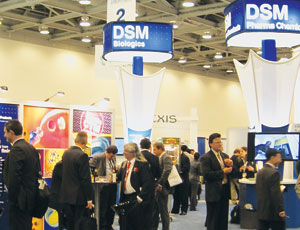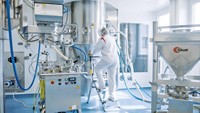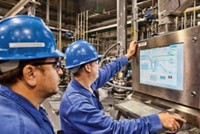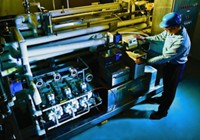Advertisement
Grab your lab coat. Let's get started
Welcome!
Welcome!
Create an account below to get 6 C&EN articles per month, receive newsletters and more - all free.
It seems this is your first time logging in online. Please enter the following information to continue.
As an ACS member you automatically get access to this site. All we need is few more details to create your reading experience.
Not you? Sign in with a different account.
Not you? Sign in with a different account.
ERROR 1
ERROR 1
ERROR 2
ERROR 2
ERROR 2
ERROR 2
ERROR 2
Password and Confirm password must match.
If you have an ACS member number, please enter it here so we can link this account to your membership. (optional)
ERROR 2
ACS values your privacy. By submitting your information, you are gaining access to C&EN and subscribing to our weekly newsletter. We use the information you provide to make your reading experience better, and we will never sell your data to third party members.
Business
Upswing Ahead
An emerging biotech bonanza riveted contract manufacturers at Informex
by Rick Mullin
March 5, 2007
| A version of this story appeared in
Volume 85, Issue 10

The Informex custom manufacturing trade show in San Francisco last month was abuzz about Pfizer's recently announced reorganization plans, but not for the reason one might think. Although contract service firms were heartened by Pfizer's plan to close manufacturing sites in the U.S. and Ireland, what seemed more exciting was the bellwether drug company's announcement that, every year beginning in 2010, it intends to commercialize two products obtained from outside the company.
In an industry that tends to nurture latent trends that suddenly emerge to exert a real force on the market—the competitive threat from India and China being an obvious example—Pfizer's stance is tacit acknowledgment that the new front of activity is now with emerging pharmaceutical and biopharmaceutical companies that license product candidates to big drugmakers. Informex attendees agreed that small, innovative drug discovery companies that have traditionally fallen short on funding and viable drug candidates have seen their fortunes reverse and are now in the market for contract chemistry services.
Contract manufacturers used to have little interest in pursuing relationships with emerging companies, instead focusing all their attention on large-scale projects with big pharma, says James Bruno, director of the consulting firm Chemical & Pharmaceutical Solutions. But between the breadth of small molecules in the biotech pipeline and the challenges faced by big pharma, contract manufacturers have changed their tune. "They are now starting to realize that working with Pfizer and Merck is not the best strategy," Bruno says.
Furthermore, small biotech firms don't have the money, the manpower, or the experience to install their own Food & Drug Administration-approved manufacturing capacity, a scenario that translates into long-term opportunities for contract manufacturing organizations.
Statistics on venture capital investment and licensing deals in the biotech sector highlight the upswing in opportunity for contract manufacturers. According to biotechnology industry analyst Burrill & Co., U.S. venture capital investment in the sector rose from $3.5 billion in 2005 to $4.2 billion last year. The value of U.S. partnerships between drug companies and biotech firms rose from $17.2 billion in 2005 to $19.7 billion last year after a 55% increase from 2004 to 2005.
This cash inflow has already translated into increased sales for custom manufacturers. "There is a tremendous amount of activity from the emerging companies," says Steven M. Klosk, executive vice president of Cambrex' pharmaceutical products and services division. "They are better financed, and some of them are doing licensing deals with midsized and large-sized pharma whose pipelines are perhaps a little less robust than they had been."
After a string of divestitures, Cambrex is now focused on the development and manufacturing of small-molecule pharmaceutical chemicals for both innovator and generic drug companies. Klosk says his division, which works mostly with innovators, grew 50% last year, and he expects double-digit growth again in 2007. "A lot of it in the U.S. is driven by the emerging guys," he says.
David Ager, principal scientist with DSM, agrees that the emerging companies now constitute a growth market for contract firms that have traditionally focused on major drug companies. "The smaller, venture-capital-funded companies are really taking off," Ager says. "They need a lot of help to advance a compound. And it's not so much a matter of chemistry."
The rise of the biotech sector is prompting fine chemicals suppliers to shift to more comprehensive services such as drug formulation, regulatory filing, and other steps needed to win FDA approval. But the chemistry also needs to fit, Ager adds.
Biotechnology is the real source of innovation in the drug industry, says Xavier Jeanjean, commercial director for pharmaceuticals and cosmetics at French contract manufacturer Isochem. But the biotech companies need a lot of help. "They have none of the chemists, none of the tools, and none of the regulatory experience for active pharmaceutical ingredients. They are coming to us for a full package of services," he says. Ultimately, he says, biotech companies are looking for project management. "We have a huge track record with FDA. We are not delivering a commodity service."
Jeanjean says Isochem's traditional focus on high-value, difficult-to-handle chemistry positions it well for the biotech market. "It's always been very risky," he acknowledges. "But now we can see which companies are the good ones. And at the end of the day, it comes down to human chemistry. You have to be able to trust people."
While SNPE, Isochem's parent company, said last year that it is studying the option of divesting the fine chemicals unit, Jeanjean claims such an action is not likely at this time. He notes that the business exceeded its targets in 2006 and has just finished a $4 million pilot-scale plant in Vert-le-Petit, France. The company also decentralized R&D last year.
With the changes, Jeanjean says, the focus on small innovators will grow. "We see that big pharma is more interested in India and China and in insourcing," he says.
Over at International Specialty Products, small innovators are also at center stage. The company is now better geared for business with biotechs thanks to a kilo lab in operation since 2005 in Columbus, Ohio, reports John E. Sim, general manager of fine chemicals. The company, which specializes in low-temperature reactions and boronic acid chemistry, is experiencing an increase in requests for production of pharmaceutical chemicals for Phase I clinical trials, according to Sim. "There is definitely a shift to biotech business, especially in cancer drugs," he says.
According to Sim, this new business is increasing the need for risk management skills. "The real talent necessary to succeed is the ability to assess the biotech's technology, personnel, and finances," he says. "As a result, our scientists are more business adept, and sales staff has become more science adept."
At Degussa, meanwhile, emerging pharmaceutical and biotech companies will soon account for a third of the sales of its exclusive synthesis business, according to Rudolf Hanko, who heads the unit. "It was below 10% four years ago," he says.
Hanko, however, sees the market segmenting less along the lines of big pharma versus emerging pharma than along the lines of what he calls strategic versus opportunistic players. "There are companies, large and small, with a strategic policy that says, 'We don't invest in our own assets to produce APIs and intermediates,' " Hanko says. "These customers are the focus of our business. There are also opportunistic customers, who are, of course, welcome customers. At the same time, we have to deal with volatility if we deal with these opportunistic customers."
Certainly, those strategic customers that also are biotech firms come with their own brand of volatility: They are candidates to partner with or be acquired by big drug companies, most of which have plenty of their own manufacturing capabilities. Hanko, however, is not overly concerned about the loss of business that such a change of control could bring.
Frank Wicks, president of Sigma-Aldrich's SAFC unit, agrees. "People worry that, once a small company is sold, the big pharma owner will take the manufacturing inside," he says. "We haven't found that it happens like that. The new owner is happy to have us continue working on the project. Most of the big guys are already outsourcing." He says SAFC's business with biotech companies is growing as projects the company has been working on for years move into clinical trials.
Looking across the industry, Wicks sees growing interaction between big drug companies and biotech firms and much money flowing into the sector. The average value of licenses, he says, has nearly quadrupled in the past four years.
That increased interaction is influencing the respective roles of small firms and their big pharma partners, Wicks suggests. "What will research look like in five years?" he asks. "It used to be big pharma did R&D and marketing. Maybe they'll just do marketing. This is a question more than a conclusion."
An interesting possibility, but until it happens, large pharmaceutical companies are still important customers that no contract manufacturer is ignoring. "This is a far better market than it was five years ago," says Cambrex' Klosk. "And I would say that while emerging pharma is an important market for us both in the U.S. and in Europe, we're doing a lot more business with midsized and large-sized pharma. Everybody read the Pfizer announcement."
Read More
- Companies At Informex Show What They've Got
- Move to spring 2008 highlights competition in world of fine chemicals exhibitions
- Informex Europe Debut Is Postponed









Join the conversation
Contact the reporter
Submit a Letter to the Editor for publication
Engage with us on Twitter